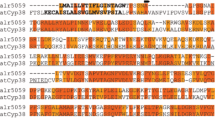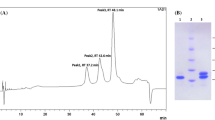Abstract
Plant seeds contain a number of proteins which play important roles in the protection and the process of germination of seeds. We have isolated and purified a 25 kDa protein from Kabuli Chana (Cicer arietinum L., Chickpea-white, CW-25). The CW-25 protein was crystallized using 0.5 M magnesium acetate, 0.1 M sodium cacodylate and 20 % (w/v) polyethylene glycol 8000, pH 6.5. The crystals of CW-25 belonged to space group P3 with unit cell dimensions, a = b = 80.5 Å, and c = 69.2 Å. The structure of CW-25 was determined using molecular replacement method and refined to an R factor of 0.152. The buried surface area between two molecules was found to be approximately 653 Å2 indicating the formation of a weak homodimer. The polypeptide chain of CW-25 adopted a hemopexin-fold with four-bladed β-propellers. The structure formed a central tunnel-like architecture. A magnesium ion was observed in the centre of the tunnel. It was located at distances varying between 2.3 and 2.7 Å from five oxygen atoms of which four were backbone oxygen atoms belonging to residues, Asn7, Asp65, Asp121 and Asp174 while the fifth oxygen atom, Oδ1 was from the side chain of Asn7. The approximate length of the tunnel was 30 Å. Furthermore, a series of carbonyl oxygen atoms were present along the internal face of the tunnel. The diameter of the tunnel varied from 4.6 to 6.2 Å. The diameter and chemical environment of the tunnel clearly indicated that it might be used for the transport of various metal ions across the molecule.






Similar content being viewed by others
References
Balaji P, Arun KP, Senthil KR, Meenakshi SM, Brindha P (2012) Isolation and identification of adaptogenic protein from cicer arietinum linn. Int J Pharm Pharm Sci 4:79–82
Osborne TB, Campbell GF (1898) Proteids of the pea. J Am Chem Soc 20:348–362
Broekaert WF, Cammue BPA, De Bolle MFC, Thevissen K, De Samblanx GW, Osborne RW (1997) Antimicrobial peptides from plants. Crit Rev Plant Sci 16(3):297–323
Kermode AR (2011) Plant storage products (carbohydrates, oils, and proteins). eLS. doi:10.1002/9780470015902.a0001325.pub2
Kochhar S, Gartenmann K, Juillerat MA (2000) Primary structure of the abundant seed albumin of Theobroma cacao by mass spectrometry. J Agric Food Chem 48:5593–5599
Harley SM, Beevers H (1986) Lectins in castor bean seedlings. Plant Physiol 80:1–6
Mishra A, Prasad R, Das M, Dwivedi PD (2009) Probing novel allergenic proteins of commonly consumed Indian legumes. Immunopharmacol Immunotoxicol 31:186–194
Misra A, Kumar R, Mishra V, Chaudhari BP, Tripathi A, Das M, Dwivedi PD (2010) Partial characterization of red gram (Cajanuscajan L. Mill sp) polypeptides recognized by patients exhibiting rhinitis and bronchial asthma. Food Chem Toxicol 48:2725–2736
Gaur V, Chanana V, Jain A, Salunke DM (2011) The structure of a haemopexin-fold protein from cow pea (Vigna unguiculata) suggests functional diversity of haemopexins in plants. Acta Crystallogr. Sect F Struct Biol Cryst Commun 67:193–200
Kumar S, Kapoor V, Gill K, Singh K, Xess I, Das SN, Dey S (2014) Antifungal and antiproliferative protein from Cicer arietinum: a bioactive compound against emerging pathogens. Biomed Res Int. doi:10.1155/2014/387203
Qureshi IA, Sethi DK, Salunke DM (2006) Purification, identification and preliminary crystallographic studies of an allergenic protein from Lathyrus sativus. Acta Crystallogr, Sect F Struct Biol Cryst Commun 62:869–872
Chanana V, Kaur KJ, Salunke DM (2004) Purification, identification and preliminary crystallographic characterization of a novel seed protein from Vigna unguiculata. Acta Crystallogr D Biol Crystallogr 60:2100–2103
Sharma U, Katre UV, Suresh CG (2015) Crystal structure of a plant albumin from Cicer arietinum (Chickpea) possessing hemopexin fold and hemagglutination activity. Planta 241(5):1061–1073
Meng L, Feldman L (2010) A rapid TRIzol-based two-step method for DNA-free RNA extraction from Arabidopsis siliques and dry seeds. Biotechnol J 5:183–186
Otwinowski Z, Minor W (1997) Processing of X-ray diffraction data collected in oscillation mode. Methods Enzymol 276:307–326
Navaza J (1994) AMoRe: an automated package for molecular replacement. Acta Cryst A 50:157–163
Murshudov GN, Vagin AA, Dodson EJ (1997) Refinement of macromolecular structures by the maximum-likelihood method. Acta Crystallogr D Biol Crystallogr 53:240–255
Collaborative Computational Project, Number 4 (1994) The CCP4 suite: programs for protein crystallography. Acta Crystallogr D Biol Crystallogr 50(5):760–763
Potterton E, Briggs P, Turkenburg M, Dodson E (2003) A graphical user interface to the CCP4 program suite. Acta Crystallogr D Biol Crystallogr 59:1131–1137
Emsley P, Cowton K (2004) Coot: model-building tools for molecular graphics. Acta Crystallogr D Biol Crystallogr 60:2126–2132
Jones TA, Zou JY, Cowan SW, Kjeldgaard M (1991) Improved methods for building protein models in electron density maps and the location of errors in these models. Acta Crystallogr A 47:110–119
Acknowledgments
The authors thank department of Science and Technology (DST), New Delhi and Department of Biotechnology (DBT) and Indian Council of Medical Research, New Delhi for financial support. They thank DBT for facilitating the beam line BM-14 at the European Synchrotron Radiation Facility, Grenoble, France. TPS also thanks the Indian National Science Academy for the Grant of position of INSA-Senior Scientist.
Author information
Authors and Affiliations
Corresponding author
Ethics declarations
Conflict of interest
Authors have no conflict of interest.
Rights and permissions
About this article
Cite this article
Kumar, S., Singh, A., Yamini, S. et al. Crystal Structure of Mg2+ Containing Hemopexin-Fold Protein from Kabuli Chana (Chickpea-White, CW-25) at 2.45 Å Resolution Reveals Its Metal Ion Transport Property. Protein J 34, 284–290 (2015). https://doi.org/10.1007/s10930-015-9624-z
Published:
Issue Date:
DOI: https://doi.org/10.1007/s10930-015-9624-z




